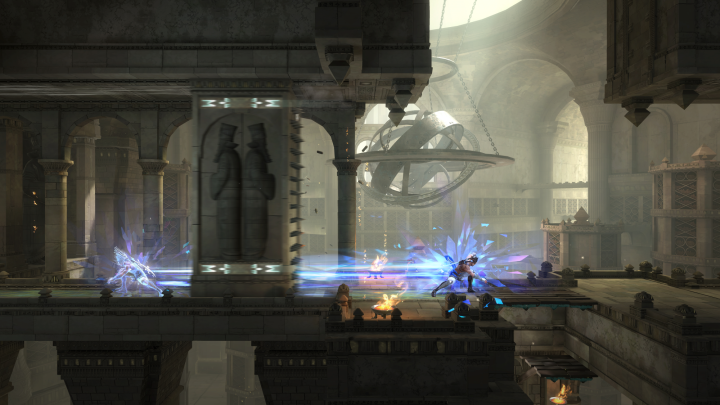When I played an hour of Prince of Persia: The Lost Crown earlier this summer, I thought I had a good handle on what to expect. I figured it would be a standard eight-hour Metroidvania that went heavier on combat and exploration than storytelling. I figured it would be a smaller release for Ubisoft, giving us a reprieve from its massive open-world games.
Boy, was I wrong.
Based on demoing the first four hours of the game, Prince of Persia: The Lost Crown is a lot more expansive than I realized. During my time with it, I’d meet a wide cast of characters, explore a ton of biomes, and complete a host of sidequests that had me taking down some tough optional bosses. With the final game estimated to last 20 to 25 hours, don’t expect a breezy side game to sneak in between early 2024’s RPG rush as it’s a surprisingly massive beast in and of itself.
A great, big 2D world
While my demo earlier this summer would throw me a few hours in with several upgrades unlocked, this time I got to start right from the top. I expected that I’d begin with a very limited tool set that I’d need to build up over time, but that wasn’t the case. Right out the gate, Sargon (the adventure’s hero) has a full range of attacks that instantly make for one of the most complex combat systems I’ve seen in the genre. I can juggle enemies into the air, perform a range of aerial combos, and even dash into them to knock them back with a kick. It’s fast and furious right out the gate, allowing for lots of player self-expression.
I’d get to take that system to its limits in a handful of boss fights, some of which thoroughly kicked my butt. One battle against a rampaging pig had me dodging under its legs to avoid its poison spit and then getting a few slashes in before it tried to kick me with its hind legs. Evasion and blocking are key in boss battles, bringing it very close to Metroid Dread in feel. During that fight, I’d play a game of chicken with the hog as it dashed toward me. I hit my block at the last second to parry its charge, giving me a supremely badass animation of Sargon tossing it aside.

The first hour or so does a lot of narrative table-setting. I’d take part in a heroic siege alongside a cast of companions before my kingdom’s prince is kidnapped and I’m dropped into the wider 2D world. Throughout my first four hours, I’d meet even more characters that would upgrade my weapons, sell me items, and pass out heaps of sidequests. One had me hunting down a special amulet, though I’d have to dodge a room full of spinning blades to nab it. Another had me fighting a shadow version of Sargon — and it’s a fight I could have easily missed if I hadn’t gone off the beaten path.
The Lost Crown’s world seems massive so far and full of things to collect. In that sense, it’s very much a traditional Ubisoft game, but distilled into a 2D platformer. I’d hunt down collectible pieces of lore, find amulets that I could equip to give Sargon buffs, smash well-hidden pots to complete an overarching sidequest, and snag extra Athra abilities that gave me more powerful special attacks. For genre veterans who fancy themselves completionists, it’ll be very easy to lose hours poking around the various biomes for secrets.
It helps that it’s just so pleasurable to actually play. While I only got a few permanent powers, the platforming is a smooth callback to Prince of Persia’s 2D roots while peppering in more complex movements you’d expect from a game like Ori and the Will of the Wisps. Some puzzle rooms would have me thinking fast as I wall jumped between spikes, grabbed hold of a bar, swung off it, and did a midair dash over some deadly blades. Even early in the game, I’m already hitting some tough platforming challenges that yield a useful reward.

All of this gives The Lost Crown the ingredients it needs to be a genre classic, though my demo left me with one hesitation. Twenty-five hours can be a tall order for a game like this, especially one that requires a lot of backtracking. I’d only unlock a handful of fast travel points during my session, all of which were spaced fairly far apart. I’d need to physically go to one to travel to another, which meant that I spent a lot of time trekking to a warp point so I could jump to one vaguely close to where I needed to be. I’d leave a lot of avenues unexplored during my session as I couldn’t find an easy way to get back to certain biomes without making a five-minute trip full of frequent pauses to check my map. My hope is that I just missed a few well-hidden ones and traversal will be a little more convenient in the full game.
Seemingly aware of how that could be a pain, Ubisoft does include one small genre innovation that could go a long way. As is traditional in Metroidvanias, I often hit rooms featuring obstacles I couldn’t quite tackle yet as I didn’t have the right power-up. When I did find one, I could press a button on my D-pad to snap a picture of that room, which is stored on my map. That means I’m never left forgetting what’s tucked away in some far-off room. I can easily check instead of backtracking. That’s an excellent little feature that even the Metroid series could desperately use.
With its release date only a month away, Prince of Persia: The Lost Crown is in very strong shape already. It nails everything that a good Metroidvania needs to succeed and goes even further with more story and gameplay systems. If you’re the kind of person who found yourself angry when you learned it would cost a full $60, trust me: There’s enough adventure here to earn that price tag.
Prince of Persia: The Lost Crown launches on January 15 for PC, PlayStation 4, PS5, Xbox One, Xbox Series X/S, and Nintendo Switch.



